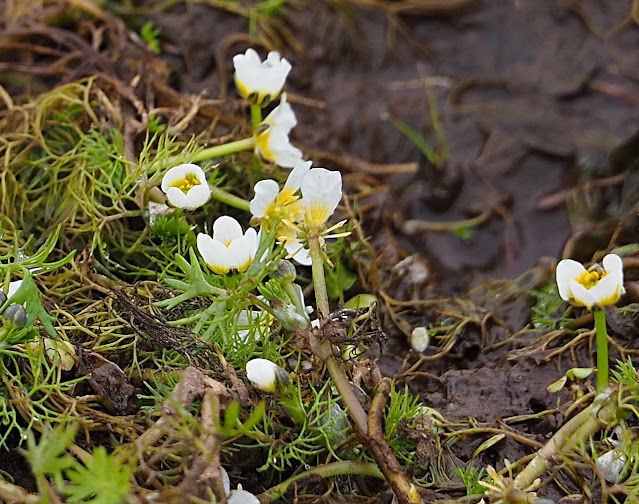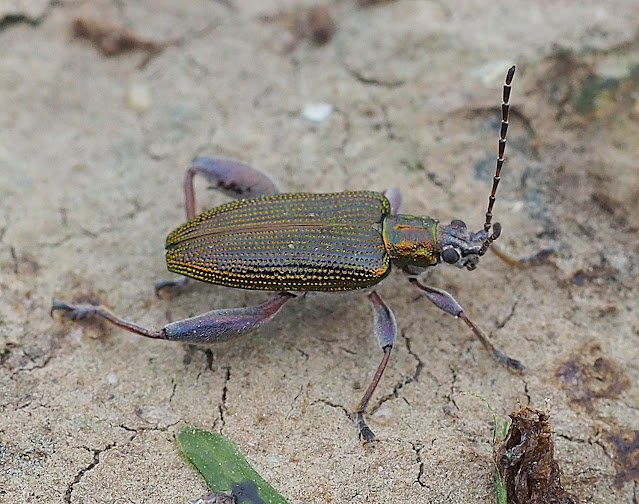This is the activity that I use my time for since I retired from my paid work, nearly two years ago now. Identifying species in the natural, and not so natural, world, and recording those identifications.
One of the aspects of retirement that some folk find hard is their own identification on leaving work. I've read and heard several accounts of these difficulties. One that sticks in the mind is of a prison officer who on his last day handed in his credentials, ID, keys etc. and after 30 years working in the same place that was it, finished, life completely changed in a moment. Fortunately, this was someone who found another purpose in their life, another passion, he had clearly been very good at his job and he was very good at what he did subsequently. But that's not true for many people, they struggle with the loss of routine, with the loss of status, with the loss of their very identity.
Fortunately, I never identified especially with my role, my job. I enjoyed it, it was challenging and interesting but it wasn't who I was or am. And when it finished I just let the other aspects of my life grow, or grow back. I was fortunate in that I had quite a few weeks of wind down, a bit of time to adjust to change, maybe everyone should have that opportunity? And I was pleased to go, I was no longer able to sustain the intensity of what my job required, and importantly I didn't want to do it any longer, I knew the time for change was upon me.
However, I know I am fortunate, amongst the older population there are many who retire and and lose themselves, no longer know themselves with nothing, they feel, to identify themselves.
Things happen quickly, indeed so quickly I've put this clip in the video twice! Orkney Vole crossing a footpath. (Best to play in YouTube I think, although that's a bit of a nuisance.)
Back in May I spent a lot of time trying to identify some Ichneumonoidea that I found in the pheromone traps. These were from family Campopleginae and they proved very difficult. I never got to an identification myself but I did learn a lot about identifying Ichneumoidea. In the end I took up a kind offer from AG to take the specimens.
There were two species involved that had been collected from the pheromone traps on 8th and 10th May. A single male of one species AG identified as Stenomacrus sp. This could not be taken further. The other specimens, four males and a female AG identified as Phobocampe species. The key for Phobocampe is almost impossible to use as it relies on subtle differences in the pattern of carinae (ridges) on the propodeum I believe. However, AG took my captures into the NHM and compared them against specimens in the collection. Result! Phobocampe crassiuscula, with the males and the female being assigned to the same species. This is a new species for Orkney, although it is believed to be common and found across Scotland. Many thanks to AG for persevering with these. I have a theory that these wasps might sense and be attracted to the pheromones as they might lead to hosts to parasitise. There's a decent PhD in that theory I suspect!
 |
| All male Phobocampe crassiuscula. |
I have a few Ichneumons to identify now, one I was given today, but most come from inside our house, I keep finding them on the windows. Presumably they are getting in via the conservatory, where we leave some windows open, and ending up on the large kitchen window which I keep checking.
 |
| Adalia decempunctata, 10-spot Ladybird. |
Ladybirds are very uncommon in Orkney, so one on said kitchen window was notable.
We've had some sunny days recently, and with the sun came the insects. Huge numbers of insects indeed. On Saturday afternoon the Wee Wood was heaving with hoverflies and other Dipterans (which I mostly chose to ignore) with moths and with a fair few Hymenoptera (now awaiting identification).
 | |
| Glyphipterix simpliciella, presumed male. |
This species was engaging in some interesting display behaviour, I presume these were males. In the past I've only seen this species nectaring in Dandelions and other yellow flowers.
(Best to play videos direct from Youtube it seems.)
 |
| Nettle-tap. |
 |
| Sandy Carpet. |
 |
| Syndemis musculana. |
In the garden a Great Yellow Bumblebee was a very nice surprise.
 |
| Bombus distinguendus. |
I've made a couple of trips to Loch of Wasdale. Mostly to hunt for Cheilosia hoverflies. I found the Cheilosia but failed to capture any to prove which species were there, unfortunately.
However, the trips to Loch of Wasdale were very worthwhile in other ways. Interesting birds, including Cuckoo x2, Willow Warbler, singing and on the migrant front first Whimbrel and then Greenshank.
At Wasdale it would be impolite not to say hello to the Pelophilus borealis population.
And in doing this I came across a sought after beetle.
 |
| Plateumaris discolor. |
I also found a large number of the Green Dock Beetle right at the shore's edge. There were mating pairs and gravid females. I can only think that this was a strategy to deposit eggs on fast growing tender new plants, but it seems a risky strategy.
 |
| Gastrophysa viridula, in cop. |
There were some hoverflies that were more photogenically inclined.
 |
| Platycheirus manicatus, female. |
There was also an interesting plant.
 |
| Common Water-crowfoot, possibly. |
Apparently, although I thought this might be a straightforward identification this could be Brackish Water-crowfoot. Seed pods need to be dissected in order to be sure of the identification. Fortunately, a trip to pick up an Ichneumon this afternoon also resulted in my being given a small sample containing the required seed pods, dissection time tomorrow.
Finally, a note about my doom and gloom of the last post. In the meantime I've managed to find Arctic Terns nesting in three places, one of which is Skiba Geo where they seem to have returned after a brief absence. Just 15 sitting birds, and very few at the other two sites but they are there and nesting.
 |
| Arctic Terns, nesting Eider and Oystercatcher's beady eye. |










No comments:
Post a Comment